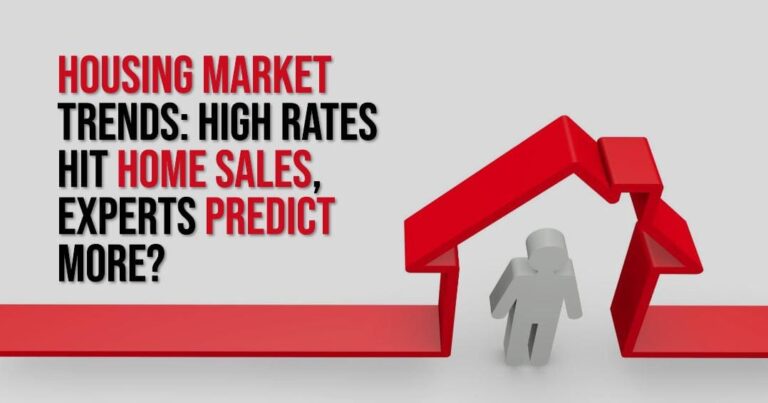The US housing market appears to be taking a breather in April 2024, with existing home sales declining for the second consecutive month. This has occurred even though overall inventories have increased, indicating a complex interplay of various factors.
Highlights:
- Existing home sales in April decreased by a seasonally adjusted annual rate of 1.9% to 4.14 million units. According to NAR
- Rising mortgage rates, which have been hovering around 7%, have dampened demand, especially for entry-level homes, which remain scarce.
- Supply constraints appear to be playing a key role, with many homeowners reluctant to sell due to low mortgage rates.
- The median price of existing homes continued its upward trend, hitting a new high of $407,600 in April.
A lull after the boom
The housing market will slow in April 2024, following a period of strong growth in the first quarter supported by a recovery in mortgage rates. This may seem counterintuitive at first glance. However, this can be explained by considering the typical lag between changes in mortgage rates and their impact on the housing market.
When mortgage rates rise, buyers take time to adjust their purchasing power and sellers take time to react to new market conditions. Therefore, the surge in homebuilding activity in the first quarter may reflect decisions taken earlier, when mortgage rates were still relatively low. As a result, we are currently seeing periods of stagnant or slightly declining sales volumes as the market adjusts to higher borrowing costs.
Is inventory the culprit?
The report highlights that overall housing inventory has increased, reaching a 2-1/2-year high in April. This may signal a shift towards a balanced market. But the data reveals an important detail: entry-level housing remains in short supply.
With mortgage rates historically low, many homeowners are reluctant to sell, creating an “inventory bottleneck.” This limits the options of buyers, especially first-time buyers, which is important for a healthy housing market. Additionally, inventory growth is concentrated in more expensive homes ($1 million and above), which may be less attractive to most buyers.
Impact on house prices and sales
Despite the slowdown in sales, home prices continue to rise. The median existing home price in April reached a record high of $407,600, reflecting a 5.7% year-over-year increase. This trend is likely to continue for several reasons. First, as mentioned earlier, there is a limited supply of homes available for sale, especially in the affordable category.
This puts upward pressure on prices as buyers compete for shrinking options. Second, even if sales volumes decline, there are still buyers in the market who are willing to pay the asking price, especially if they have a strong financial foundation and are confident in their long-term housing needs. .
Finally, new home construction is also slowing in response to rising borrowing costs. This further limits supply, contributing to higher prices. However, it is important to note that this trend may not be sustainable in the long term. If mortgage rates continue to rise or economic conditions worsen, buyer demand could decline more significantly, ultimately putting downward pressure on home prices.
Looking to the future: A balancing act
The future of the housing market depends on the actions of the Federal Reserve. Mortgage rates aren’t expected to drop significantly until 2025, as the Federal Reserve aims to curb inflation by raising interest rates. As a result, sales volume may remain stagnant for an extended period or decline gradually. However, it appears likely that both buyers and sellers will take a wait-and-see attitude until there is more clarity on the Federal Reserve’s monetary policy actions and their impact on mortgage rates.
Beyond the numbers: Tips for the changing housing market
Although the data provides a snapshot of the current state of the market, there are underlying trends that could influence its future trajectory. Areas to watch out for are:
- First-time buyers: Their continued presence in the market (albeit slightly reduced compared to the previous year) is a positive indicator. But their ability to compete for limited affordable housing depends on a combination of factors, including wage growth and potential changes in mortgage rates.
- Defective sales: The rise in the “distressed sales” rate, although small, could signal an increase in foreclosures in the coming months. While this may ultimately lead to more properties becoming available, it is important to keep in mind that foreclosures typically take a long time to go through the legal system.
- Regional variations: National sales numbers mask potential regional variations. Depending on local economic conditions and home price factors, some areas may experience a sharper decline in sales volume than others.
summary
The US housing market presents a mixed picture in April 2024. Although sales are down, prices remain high, especially for entry-level homes, due to limited inventory. The interplay between mortgage rates, seller behavior, overall economic conditions, and regional fluctuations will be key factors shaping the market trajectory in the coming months.
It remains to be seen whether this slowdown will result in a prolonged period of adjustment or just a temporary lull. Monitoring these trends is essential for both buyers and sellers navigating this dynamic market environment.
Also read:
Housing market forecast for the next five years (2024-2028)
Housing market forecast for the next two years
Housing market forecasts for 2024 and 2025 remain important
Housing market trends and summer buying season predictions
Housing market trends: 90% of metropolitan areas expect price increases in 2024

